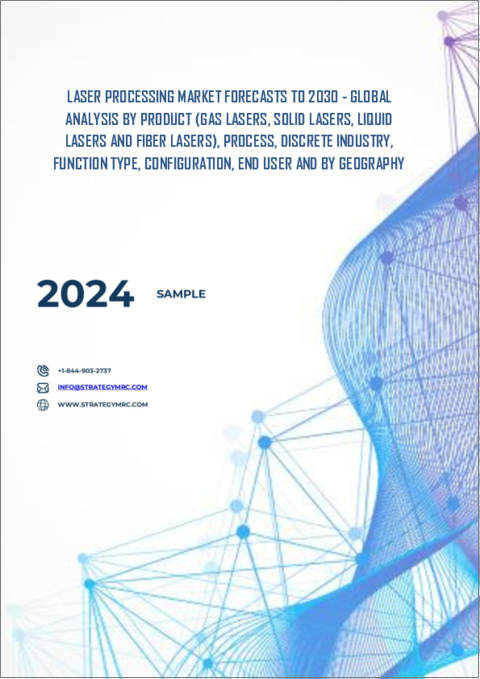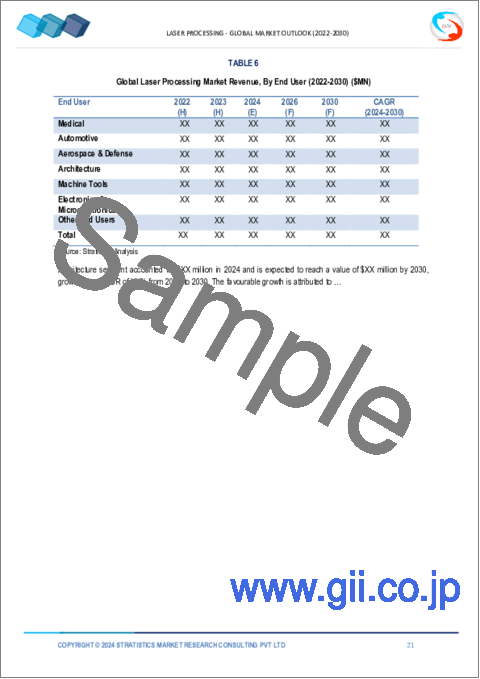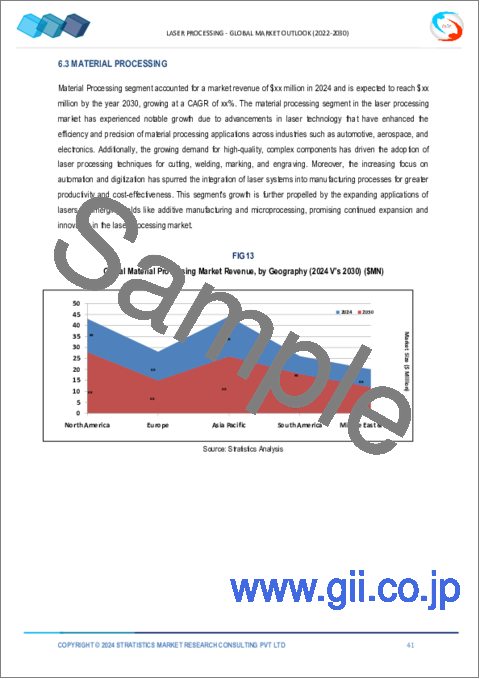|
|
市場調査レポート
商品コード
1476423
レーザー加工市場の2030年までの予測:製品タイプ、プロセス、ディスクリート産業、機能タイプ、構成、エンドユーザー、地域別の世界分析Laser Processing Market Forecasts to 2030 - Global Analysis By Product (Gas Lasers, Solid Lasers, Liquid Lasers and Fiber Lasers), Process, Discrete Industry, Function Type, Configuration, End User and By Geography |
||||||
カスタマイズ可能
|
|||||||
| レーザー加工市場の2030年までの予測:製品タイプ、プロセス、ディスクリート産業、機能タイプ、構成、エンドユーザー、地域別の世界分析 |
|
出版日: 2024年05月05日
発行: Stratistics Market Research Consulting
ページ情報: 英文 200+ Pages
納期: 2~3営業日
|
全表示
- 概要
- 図表
- 目次
Stratistics MRCによると、世界のレーザー加工市場は2023年に60億米ドルを占め、予測期間中にCAGR 12.1%で成長し、2030年には134億米ドルに達する見込みです。
レーザー加工は、集束した強い光ビームを使用して材料を加工します。製造、ヘルスケア、エレクトロニクスなど多様な産業において、切断、溶接、彫刻、マーキングなど様々な技術が含まれます。レーザーの高いエネルギー密度は、物理的な接触なしに正確な材料除去や加工を可能にし、周囲へのダメージを最小限に抑えます。CO2レーザー、ファイバーレーザー、ダイオードレーザーなど、さまざまな種類のレーザーは、波長と出力に基づく独自の利点を提供します。レーザー加工は、複雑なデザイン、迅速なプロトタイピング、高速生産を容易にし、無駄を省きながら効率と品質を高めます。その多用途性と精度は、現代の製造および研究用途において不可欠なものとなっています。
最近の全米製造業者協会の調査によると、パンデミックは金属製造業者の80%以上に経済的苦境をもたらし、業界の成長に悪影響を及ぼしました。
従来の技術に対する優位性
レーザー加工は、機械的切断や手作業による彫刻のような従来の技術に比べて、比類のない精度と正確さを提供します。この精度により、メーカーはより厳しい公差を達成し、複雑なデザインを一貫した品質で製造することができ、業界全体でレーザーシステムの需要を牽引しています。このような柔軟性により、メーカーは生産プロセスを合理化し、単一の技術プラットフォームで多様なアプリケーションのニーズに対応することができるため、レーザーシステムの採用が増加し、市場の成長を後押ししています。
複雑さと熟練労働力
レーザー加工技術は複雑であるため、レーザーシステムを効果的に操作・保守するにはかなりの専門知識が必要になることが多いです。このため、中小企業やレーザー加工に新規参入する企業にとっては、技術を採用するためのリソースや専門知識が不足し、参入障壁となる可能性があります。さらに、レーザシステムの操作やトラブルシューティングに習熟するための従業員トレーニングプログラムや継続教育に投資することは、運用経費を増加させ、一部の企業ではレーザ技術の採用を思いとどまらせ、市場の成長を妨げる可能性があります。
自動化とスマート製造へのシフト
自動化とスマート・マニュファクチャリングには、統合されたデジタル接続環境で効率的に動作する高度な生産技術が必要です。レーザ加工システムは、その精度、スピード、適応性により、これらの要件に適しています。産業界が製造プロセスを自動化し、スマート技術を採用するにつれて、切断、溶接、マーキング、彫刻アプリケーション用のレーザーシステムの需要が高まっています。
限られた材料加工性
レーザー加工技術は、高反射率、透明性、感熱性などの特性を持つ特定の材料には適さない場合があり、レーザー加工システムは主にその技術に適合する材料を対象としています。このため、より広範な材料の加工を必要とする製造業者にとっては、機会を逃す結果となり、代替の製造方法を模索する原動力となる可能性があります。この制限は、レーザー加工が効果的に使用できるアプリケーションの範囲を制限し、特にこれらの材料が一般的に使用される産業において、市場の需要と採用に影響を与えます。
COVID-19の影響
遠隔作業や安全プロトコルに適応した産業では、特に医療機器、電子機器、パッケージングでレーザー加工ソリューションの需要が急増しました。非接触生産と自動化のニーズは、レーザー技術の採用をさらに加速させました。さらに、オンライン小売へのシフトは、ブランディングやトレーサビリティのためにレーザーマークや刻印を施した製品の需要を押し上げました。全体として、パンデミックは課題をもたらしたが、同時に技術革新を促し、レーザ加工市場の長期的成長を促進しました。
ファイバレーザセグメントが予測期間中最大になる見込み
ファイバーレーザは高効率であり、入力エネルギーの大部分を出力レーザパワーに変換します。この効率は、レーザ加工アプリケーションの運用コスト低減と生産性向上につながります。さらにファイバーレーザは、優れたビーム品質と安定性を持つ高品質のレーザビームを生成します。これにより、正確で一貫性のある加工が可能になり、優れた製品品質とスクラップ率の低減が実現します。
マーキング&エングレービングセグメントが予測期間中最高のCAGRが見込まれる
マーキング&エングレービング分野は、高精度、可変深度制御、微細加工能力などの特殊な特性を持つ特殊レーザーシステムにより、予測期間中に最も高いCAGR成長が見込まれています。このため、ファイバーレーザー、ダイオード励起レーザー、CO2レーザー、UVレーザーなど、マーキングと彫刻アプリケーションの多様なニーズに対応した幅広いレーザー技術が開発されています。
最大のシェアを占める地域
高出力レーザ、ファイバレーザ、超高速レーザの市場開拓など、レーザ技術の進歩が進み、中国や日本のレーザ加工システムの能力が拡大したため、予測期間中、アジア太平洋が最大の市場シェアを占めると予測されています。これらの進歩は、より高い精度、より速い加工速度、より幅広い材料を扱う能力を可能にしました。さらにレーザシステムは、非接触加工、高速加工、柔軟性などの利点を備えており、この地域の自動化製造環境への統合に理想的です。
CAGRが最も高い地域:
北米のレーザ加工市場は、自動車、航空宇宙、エレクトロニクス、ヘルスケア、消費財など、さまざまな業界にサービスを提供しているため、予測期間中のCAGRは北米が最も高いと予測されています。各セクターは、レーザ加工に独自の要求を持っており、レーザ技術の革新とカスタマイズを推進しています。北米では、3Dプリンティングとしても知られるアディティブ・マニュファクチャリングが急成長しています。選択的レーザー溶融(SLM)やステレオリソグラフィ(SLA)などのレーザーベースの技術は、航空宇宙からヘルスケアまで幅広い産業で、複雑なコンポーネントのラピッドプロトタイピングや製造に利用されています。
無料カスタマイズサービス:
本レポートをご購読のお客様は、以下の無料カスタマイズオプションのいずれかをご利用いただけます:
- 企業プロファイル
- 追加市場プレーヤーの包括的プロファイリング(3社まで)
- 主要企業のSWOT分析(3社まで)
- 地域セグメンテーション
- 顧客の関心に応じた主要国の市場推計・予測・CAGR(注:フィージビリティチェックによる)
- 競合ベンチマーキング
- 製品ポートフォリオ、地理的プレゼンス、戦略的提携に基づく主要企業のベンチマーキング
目次
第1章 エグゼクティブサマリー
第2章 序文
- 概要
- ステークホルダー
- 調査範囲
- 調査手法
- データマイニング
- データ分析
- データ検証
- 調査アプローチ
- 調査情報源
- 1次調査情報源
- 2次調査情報源
- 前提条件
第3章 市場動向分析
- 促進要因
- 抑制要因
- 機会
- 脅威
- 製品分析
- エンドユーザー分析
- 新興市場
- COVID-19の影響
第4章 ポーターのファイブフォース分析
- 供給企業の交渉力
- 買い手の交渉力
- 代替品の脅威
- 新規参入業者の脅威
- 競争企業間の敵対関係
第5章 世界のレーザー加工市場:製品別
- ガスレーザー
- 固体レーザー
- 液体レーザー
- ファイバーレーザー
第6章 世界のレーザー加工市場:プロセス別
- マーキングとエングレービング
- 材料加工
- マイクロプロセッシング
- 溶接
- パンチングとマイクロマシニング
- 切断と穴あけ
- その他のプロセス
第7章 世界のレーザー加工市場:ディスクリート産業別
- 移動
- 修理済み
- ハイブリッド
第8章 世界のレーザー加工市場:機能タイプ別
- 半自動
- ロボット
第9章 世界のレーザー加工市場:構成別
- レーザー加工構成
- レーザー切断とエングレービング構成
第10章 世界のレーザー加工市場:エンドユーザー別
- 医療
- 自動車
- 航空宇宙および防衛
- 建築
- 工作機械
- エレクトロニクスおよびマイクロエレクトロニクス
- その他のエンドユーザー
第11章 世界のレーザー加工市場:地域別
- 北米
- 米国
- カナダ
- メキシコ
- 欧州
- ドイツ
- 英国
- イタリア
- フランス
- スペイン
- その他欧州
- アジア太平洋地域
- 日本
- 中国
- インド
- オーストラリア
- ニュージーランド
- 韓国
- その他アジア太平洋地域
- 南米
- アルゼンチン
- ブラジル
- チリ
- その他南米
- 中東・アフリカ
- サウジアラビア
- アラブ首長国連邦
- カタール
- 南アフリカ
- その他中東とアフリカ
第12章 主な発展
- 契約、パートナーシップ、コラボレーション、合弁事業
- 買収と合併
- 新製品発売
- 事業拡大
- その他の主要戦略
第13章 企業プロファイリング
- TRUMPF
- Alpha Nov laser
- Altec GmbH
- Amada Co., Ltd.
- Bystronic Laser AG
- Coherent Corp.
- Epilog Laser
- Eurolaser GmbH
- Han's Laser Technology Industry Group Co., Ltd
- IPG Photonics Corporation
- Jenoptik AG
- Laser Systems, Inc.
- LaserStar Technologies Corporation
- Lumentum Operation LLC
- Mazak
- Messer
- Mitsubishi
- Newport Corporation
- PrimaPower
- Xenetech Global Inc.
List of Tables
- Table 1 Global Laser Processing Market Outlook, By Region (2021-2030) ($MN)
- Table 2 Global Laser Processing Market Outlook, By Product (2021-2030) ($MN)
- Table 3 Global Laser Processing Market Outlook, By Gas Lasers (2021-2030) ($MN)
- Table 4 Global Laser Processing Market Outlook, By Solid Lasers (2021-2030) ($MN)
- Table 5 Global Laser Processing Market Outlook, By Liquid Lasers (2021-2030) ($MN)
- Table 6 Global Laser Processing Market Outlook, By Fiber Lasers (2021-2030) ($MN)
- Table 7 Global Laser Processing Market Outlook, By Process (2021-2030) ($MN)
- Table 8 Global Laser Processing Market Outlook, By Marking & Engraving (2021-2030) ($MN)
- Table 9 Global Laser Processing Market Outlook, By Material Processing (2021-2030) ($MN)
- Table 10 Global Laser Processing Market Outlook, By Micro-Processing (2021-2030) ($MN)
- Table 11 Global Laser Processing Market Outlook, By Welding (2021-2030) ($MN)
- Table 12 Global Laser Processing Market Outlook, By Punching & Micro Machining (2021-2030) ($MN)
- Table 13 Global Laser Processing Market Outlook, By Cutting & Drilling (2021-2030) ($MN)
- Table 14 Global Laser Processing Market Outlook, By Other Processes (2021-2030) ($MN)
- Table 15 Global Laser Processing Market Outlook, By Discrete Industry (2021-2030) ($MN)
- Table 16 Global Laser Processing Market Outlook, By Moving (2021-2030) ($MN)
- Table 17 Global Laser Processing Market Outlook, By Fixed (2021-2030) ($MN)
- Table 18 Global Laser Processing Market Outlook, By Hybrid (2021-2030) ($MN)
- Table 19 Global Laser Processing Market Outlook, By Function Type (2021-2030) ($MN)
- Table 20 Global Laser Processing Market Outlook, By Semi-Automatic (2021-2030) ($MN)
- Table 21 Global Laser Processing Market Outlook, By Robotic (2021-2030) ($MN)
- Table 22 Global Laser Processing Market Outlook, By Configuration (2021-2030) ($MN)
- Table 23 Global Laser Processing Market Outlook, By Laser Processing Configuration (2021-2030) ($MN)
- Table 24 Global Laser Processing Market Outlook, By Laser Cutting & Engraving Configuration (2021-2030) ($MN)
- Table 25 Global Laser Processing Market Outlook, By End User (2021-2030) ($MN)
- Table 26 Global Laser Processing Market Outlook, By Medical (2021-2030) ($MN)
- Table 27 Global Laser Processing Market Outlook, By Automotive (2021-2030) ($MN)
- Table 28 Global Laser Processing Market Outlook, By Aerospace & Defense (2021-2030) ($MN)
- Table 29 Global Laser Processing Market Outlook, By Architecture (2021-2030) ($MN)
- Table 30 Global Laser Processing Market Outlook, By Machine Tools (2021-2030) ($MN)
- Table 31 Global Laser Processing Market Outlook, By Electronics & Microelectronics (2021-2030) ($MN)
- Table 32 Global Laser Processing Market Outlook, By Other End Users (2021-2030) ($MN)
Note: Tables for North America, Europe, APAC, South America, and Middle East & Africa Regions are also represented in the same manner as above.
According to Stratistics MRC, the Global Laser Processing Market is accounted for $6.0 billion in 2023 and is expected to reach $13.4 billion by 2030 growing at a CAGR of 12.1% during the forecast period. Laser processing involves using focused beams of intense light to alter materials. It encompasses various techniques, including cutting, welding, engraving, and marking, across diverse industries like manufacturing, healthcare, and electronics. The laser's high energy density enables precise material removal or alteration without physical contact, minimizing damage to surrounding areas. Different types of lasers, such as CO2, fiber, and diode lasers, offer unique advantages based on wavelength and power output. Laser processing facilitates intricate designs, rapid prototyping, and high-speed production, enhancing efficiency and quality while reducing waste. Its versatility and accuracy make it indispensable in modern manufacturing and research applications.
According to a recent National Association of Manufacturers survey, the pandemic caused over 80% of metal manufacturers financial distress causing an adverse impact on the industry's growth.
Market Dynamics:
Driver:
Superiority over traditional techniques
Laser processing offers unparalleled precision and accuracy compared to traditional techniques such as mechanical cutting or manual engraving. This precision enables manufacturers to achieve tighter tolerances and produce intricate designs with consistent quality, driving demand for laser systems across industries. This flexibility allows manufacturers to streamline their production processes and address diverse application needs with a single technology platform, leading to increased adoption of laser systems thus propelling the growth of the market.
Restraint:
Complexity and skilled workforce
The complexity of laser processing technology often requires substantial expertise to operate and maintain laser systems effectively. This can create a barrier to entry for small and medium-sized enterprises (SMEs) or companies new to laser processing, as they may lack the resources or specialized knowledge to adopt the technology. Additionally investing in employee training programs and continuing education to ensure proficiency in operating and troubleshooting laser systems adds to operational expenses and may deter some companies from adopting laser technology which hinder the market growth.
Opportunity:
Shift towards automation and smart manufacturing
Automation and smart manufacturing require advanced production technologies that can operate efficiently within integrated, digitally connected environments. Laser processing systems are well-suited to these requirements due to their precision, speed, and adaptability. As industries automate their manufacturing processes and adopt smart technologies, there is a growing demand for laser systems for cutting, welding, marking, and engraving applications.
Threat:
Limited material processability
Laser processing techniques may not be suitable for certain materials with properties such as high reflectivity, transparency, or heat sensitivity and with laser processing systems primarily targeting materials that are compatible with the technology. This can result in missed opportunities for manufacturers who require a broader range of materials to be processed, potentially driving them to explore alternative manufacturing methods. This limitation restricts the range of applications for which laser processing can be used effectively, impacting market demand and adoption, especially in industries where these materials are commonly used.
Covid-19 Impact
Industries adapted to remote work and safety protocols, demand for laser processing solutions, particularly in medical devices, electronics, and packaging, surged. The need for contactless production and increased automation further accelerated the adoption of laser technology. Additionally, the shift towards online retail boosted demand for laser-marked and engraved products for branding and traceability. Overall, while the pandemic posed challenges, it also spurred innovation and drove long-term growth in the laser processing market.
The fiber lasers segment is expected to be the largest during the forecast period
The fiber lasers segment is estimated to have a lucrative growth, as fiber lasers are highly efficient, converting a large proportion of input energy into output laser power. This efficiency leads to lower operating costs and increased productivity for laser processing applications. Moreover fiber lasers produce high-quality laser beams with excellent beam quality and stability. This allows for precise and consistent processing, resulting in superior product quality and reduced scrap rates.
The marking & engraving segment is expected to have the highest CAGR during the forecast period
The marking & engraving segment is anticipated to witness the highest CAGR growth during the forecast period, owing to specialized laser systems with specific characteristics such as high precision, variable depth control, and fine detail capabilities. This has led to the development of a wide range of laser technologies tailored to meet the diverse needs of marking and engraving applications, including fiber lasers, diode-pumped lasers, CO2 lasers, and UV lasers.
Region with largest share:
Asia Pacific is projected to hold the largest market share during the forecast period owing to the ongoing advancements in laser technology, such as the development of high-power lasers, fiber lasers, and ultrafast lasers, have expanded the capabilities of laser processing systems in china and Japan. These advancements have enabled higher precision, faster processing speeds, and the ability to work with a wider range of materials. Moreover laser systems offer advantages such as non-contact processing, high speed, and flexibility, making them ideal for integration into automated manufacturing environments in this region.
Region with highest CAGR:
North America is projected to have the highest CAGR over the forecast period, as North American laser processing market serves various industries, including automotive, aerospace, electronics, healthcare, consumer goods, and more. Each sector has unique requirements for laser processing, driving innovation and customization in laser technologies. Further additive manufacturing, also known as 3D printing, is experiencing rapid growth in North America. Laser-based technologies such as selective laser melting (SLM) and stereolithography (SLA) are utilized for rapid prototyping and production of complex components in industries ranging from aerospace to healthcare.
Key players in the market
Some of the key players in the Laser Processing Market include TRUMPF, Alpha Nov laser, Altec GmbH, Amada Co., Ltd., Bystronic Laser AG, Coherent Corp., Epilog Laser, Eurolaser GmbH, Han's Laser Technology Industry Group Co., Ltd, IPG Photonics Corporation, Jenoptik AG, Laser Systems, Inc., LaserStar Technologies Corporation, Lumentum Operation LLC, Mazak Messer, Mitsubishi, Newport Corporation, PrimaPower and Xenetech Global Inc.
Key Developments:
In March 2024, Coherent Corp. introduced a game-changing diode laser bar for the hair removal industry. This innovative 808 nm bar employs a two-junction configuration to deliver 200 W of output with just 100 A of input current, thus doubling the efficiency of previous single-junction bars.
In March 2024, Coherent Corp. announced the introduction of two new optical test instrumentation products. The growing demand for capacity in optical networks has generated more interest in using the O-Band more effectively.
In January 2024, Bystronic Laser AG announced the introduction of ByBend Star 120, the newest member of the Bystronic family of pressbrakes, offers you bending technology for the highest demands on process speed, flexibility, and precision.
Products Covered:
- Gas Lasers
- Solid Lasers
- Liquid Lasers
- Fiber Lasers
Processes Covered:
- Marking & Engraving
- Material Processing
- Micro-Processing
- Welding
- Punching & Micro Machining
- Cutting & Drilling
- Other Processes
Discrete Industries Covered:
- Moving
- Fixed
- Hybrid
Function Types Covered:
- Semi-Automatic
- Robotic
Configurations Covered:
- Laser Processing Configuration
- Laser Cutting & Engraving Configuration
End Users Covered:
- Medical
- Automotive
- Aerospace & Defense
- Architecture
- Machine Tools
- Electronics & Microelectronics
- Other End Users
Regions Covered:
- North America
- US
- Canada
- Mexico
- Europe
- Germany
- UK
- Italy
- France
- Spain
- Rest of Europe
- Asia Pacific
- Japan
- China
- India
- Australia
- New Zealand
- South Korea
- Rest of Asia Pacific
- South America
- Argentina
- Brazil
- Chile
- Rest of South America
- Middle East & Africa
- Saudi Arabia
- UAE
- Qatar
- South Africa
- Rest of Middle East & Africa
What our report offers:
- Market share assessments for the regional and country-level segments
- Strategic recommendations for the new entrants
- Covers Market data for the years 2021, 2022, 2023, 2026, and 2030
- Market Trends (Drivers, Constraints, Opportunities, Threats, Challenges, Investment Opportunities, and recommendations)
- Strategic recommendations in key business segments based on the market estimations
- Competitive landscaping mapping the key common trends
- Company profiling with detailed strategies, financials, and recent developments
- Supply chain trends mapping the latest technological advancements
Free Customization Offerings:
All the customers of this report will be entitled to receive one of the following free customization options:
- Company Profiling
- Comprehensive profiling of additional market players (up to 3)
- SWOT Analysis of key players (up to 3)
- Regional Segmentation
- Market estimations, Forecasts and CAGR of any prominent country as per the client's interest (Note: Depends on feasibility check)
- Competitive Benchmarking
- Benchmarking of key players based on product portfolio, geographical presence, and strategic alliances
Table of Contents
1 Executive Summary
2 Preface
- 2.1 Abstract
- 2.2 Stake Holders
- 2.3 Research Scope
- 2.4 Research Methodology
- 2.4.1 Data Mining
- 2.4.2 Data Analysis
- 2.4.3 Data Validation
- 2.4.4 Research Approach
- 2.5 Research Sources
- 2.5.1 Primary Research Sources
- 2.5.2 Secondary Research Sources
- 2.5.3 Assumptions
3 Market Trend Analysis
- 3.1 Introduction
- 3.2 Drivers
- 3.3 Restraints
- 3.4 Opportunities
- 3.5 Threats
- 3.6 Product Analysis
- 3.7 End User Analysis
- 3.8 Emerging Markets
- 3.9 Impact of Covid-19
4 Porters Five Force Analysis
- 4.1 Bargaining power of suppliers
- 4.2 Bargaining power of buyers
- 4.3 Threat of substitutes
- 4.4 Threat of new entrants
- 4.5 Competitive rivalry
5 Global Laser Processing Market, By Product
- 5.1 Introduction
- 5.2 Gas Lasers
- 5.3 Solid Lasers
- 5.4 Liquid Lasers
- 5.5 Fiber Lasers
6 Global Laser Processing Market, By Process
- 6.1 Introduction
- 6.2 Marking & Engraving
- 6.3 Material Processing
- 6.4 Micro-Processing
- 6.5 Welding
- 6.6 Punching & Micro Machining
- 6.7 Cutting & Drilling
- 6.8 Other Processes
7 Global Laser Processing Market, By Discrete Industry
- 7.1 Introduction
- 7.2 Moving
- 7.3 Fixed
- 7.4 Hybrid
8 Global Laser Processing Market, By Function Type
- 8.1 Introduction
- 8.2 Semi-Automatic
- 8.3 Robotic
9 Global Laser Processing Market, By Configuration
- 9.1 Introduction
- 9.2 Laser Processing Configuration
- 9.3 Laser Cutting & Engraving Configuration
10 Global Laser Processing Market, By End User
- 10.1 Introduction
- 10.2 Medical
- 10.3 Automotive
- 10.4 Aerospace & Defense
- 10.5 Architecture
- 10.6 Machine Tools
- 10.7 Electronics & Microelectronics
- 10.8 Other End Users
11 Global Laser Processing Market, By Geography
- 11.1 Introduction
- 11.2 North America
- 11.2.1 US
- 11.2.2 Canada
- 11.2.3 Mexico
- 11.3 Europe
- 11.3.1 Germany
- 11.3.2 UK
- 11.3.3 Italy
- 11.3.4 France
- 11.3.5 Spain
- 11.3.6 Rest of Europe
- 11.4 Asia Pacific
- 11.4.1 Japan
- 11.4.2 China
- 11.4.3 India
- 11.4.4 Australia
- 11.4.5 New Zealand
- 11.4.6 South Korea
- 11.4.7 Rest of Asia Pacific
- 11.5 South America
- 11.5.1 Argentina
- 11.5.2 Brazil
- 11.5.3 Chile
- 11.5.4 Rest of South America
- 11.6 Middle East & Africa
- 11.6.1 Saudi Arabia
- 11.6.2 UAE
- 11.6.3 Qatar
- 11.6.4 South Africa
- 11.6.5 Rest of Middle East & Africa
12 Key Developments
- 12.1 Agreements, Partnerships, Collaborations and Joint Ventures
- 12.2 Acquisitions & Mergers
- 12.3 New Product Launch
- 12.4 Expansions
- 12.5 Other Key Strategies
13 Company Profiling
- 13.1 TRUMPF
- 13.2 Alpha Nov laser
- 13.3 Altec GmbH
- 13.4 Amada Co., Ltd.
- 13.5 Bystronic Laser AG
- 13.6 Coherent Corp.
- 13.7 Epilog Laser
- 13.8 Eurolaser GmbH
- 13.9 Han's Laser Technology Industry Group Co., Ltd
- 13.10 IPG Photonics Corporation
- 13.11 Jenoptik AG
- 13.12 Laser Systems, Inc.
- 13.13 LaserStar Technologies Corporation
- 13.14 Lumentum Operation LLC
- 13.15 Mazak
- 13.16 Messer
- 13.17 Mitsubishi
- 13.18 Newport Corporation
- 13.19 PrimaPower
- 13.20 Xenetech Global Inc.





